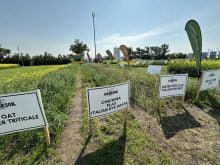Growers often dismiss the unpredictability of precipitation as pure luck — but they can stack the odds in their favour with the right strategies.
“There’s a lot of different dynamics going on with the water balance in the Prairies,” says Phillip Harder, research director and hydrologist at Croptimistic Technologies.
In addition to summer rains during the growing season adding water to the system, there’s also evaporation from the soil and transpiration from the crops removing it, he explains.
Read Also

Cancer agency reclassifies another herbicide ‘probably carcinogenic’
The WHO’s cancer research agency has now put atrazine, a herbicide well known to corn growers, in the same potential-hazard category where the agency put glyphosate.
Water then flows through runoff, subsurface flow and groundwater interactions, continuously cycling in and out of the system. And the other big consideration for water management on the Canadian Prairies is, of course, winter.
“Depending on the year, you can have eight calendar months in a row, where you’ve got snow on the ground,” Harder notes. “This is where a lot of our agro-hydrology understandings can fall apart, when we’re looking at other regions that don’t have the same winter processes.”
Water use efficiency
Harder talks a lot about water use efficiency (WUE) — which measures how effectively a crop uses water to produce yield. It’s often expressed as bushels per acre per inch of water.
Though it can vary significantly from crop to crop, it tends to remain fairly stable within a given crop type, meaning there’s little that a farmer can do to improve on that ratio.
The important thing to remember, though, is that water doesn’t have to come from precipitation during the growing season. It can also come from spring snowmelt or groundwater. So, a field that saw very little rain could still produce a good crop if there is sufficient moisture in the ground from other sources — and growers do have some limited control over that.
“We need to understand our productivity in our particular year. We need to understand our multi-year soil moisture legacies, not just the growing season rainfall,” Harder says. “It’s a complex story, but we have tools to manage these things.”

Holding on to your snow
One simple and effective tool growers can use is retaining winter snowpack with crop stubble.
“If you leave taller standing stubble in the field, you increase the aerodynamic roughness, and it basically will trap your snow where it is,” Harder explains. That’s fairly intuitive, but what might be less obvious are the implications stubble management has on sublimation.
“In places like Regina, with wide-open plains, you can have a fair bit of snow, but you also have those really intense winds,” he said. “When snow is blowing through a field, you’re losing a lot of snow straight back into the atmosphere.”
In a fallow field with no resistance, only about 23 per cent of the snow remains on the landscape, Harder says. If that same field had stubble, it could hold onto roughly 48 per cent of that snow.
In terms of water retention, Harder notes if you increase your stubble height from zero to 50 cm, on average, there would be 50 mm of water available for the crops.
“In a water-limited environment, an extra inch or two of moisture can make a difference,” he notes. However, Harder points out the impact would be less in areas with more shelter, where blowing snow is less of a concern.
Keeping water in the landscape
Another strategy farmers can employ to help them hold on to moisture is by maintaining the water already in the landscape.
“This is where your soil residues come into play,” Harder says. “If you’re able to increase the residue retention on your surface, you will basically disconnect the vapour pressure gradient between your soil and the atmosphere, and you will suppress soil evaporation.”
In other words, if you keep it covered, the water doesn’t evaporate nearly as much. The challenge is that the hydrologic implications of residue management are inconsistent. For example, tillage of a dry field doesn’t change anything, but tillage of a wet field does.
“You have to be aware what the starting point of your soil moisture is,” Harder says. “There’s a general rule of thumb that for every 10 per cent increase in cover, you might be able to reduce your soil evaporation by five per cent.”
Those numbers might sound small, but as Harder points out, they all add up.
Leveraging topography to your advantage
The topography of the land is another area producers will often look at as the hand they’ve been dealt — but there are ways to make the topography work for them.
The key, Harder says, is slowing down the water as much as possible and having it infiltrate the soil.
There are limitations. Hilltops lack the water-holding capacity of low-lying areas. Farmers could dig ditches or level hilltops, but there are easier, passive methods that require far less diesel. For example, Harder highlights the role of crop residue.
“A thick crop residue layer will really slow down water movement, and everything you can do to slow down water movement gives it the opportunity to infiltrate,” he says, noting that refraining from tillage is the obvious first step a grower can take.
“The reason we have saturated depressions comes down to that snowmelt infiltration period, so more residue slows things down, and that lets it infiltrate in place,” he added. “That’s an easy one.”
Harder said farmers could also try to leave taller stubble on hilltops and shorter stubble in the depressions — although that could be a problem because dry hilltops might not have the biomass to support that strategy.
Another way to take advantage of the landscape is variable seeding rates based on topography.
“Maybe you want to scale back your seeding rates on your hilltops, so there’s less water demand, and amp up seeding rates in depressions,” Harder offers. “It really depends on the crop type.”
Similarly, intercropping can be used. For example, a producer could plant a water-loving crop such as canola in the depressions, where it can soak up excess water, while planting something like lentils on the hilltop.
“There’s different strategies out there, but at the end of the day, there’s a lot you can do besides ditching,” Harder says.
















